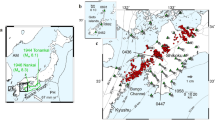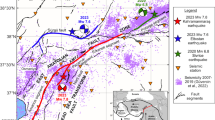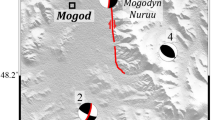Abstract
The passage of radiating seismic waves generates transient stresses in the Earth’s crust that can trigger slip on faults far away from the original earthquake source. The triggered fault slip is detectable in the form of earthquakes1,2,3 and seismic tremor4,5,6,7. However, the significance of these triggered events remains controversial8,9, in part because they often occur with some delay, long after the triggering stress has passed. Here we scrutinize the location and timing of tremor on the San Andreas fault between 2001 and 2010 in relation to distant earthquakes. We observe tremor on the San Andreas fault that is initiated by passing seismic waves, yet migrates along the fault at a much slower velocity than the radiating seismic waves. We suggest that the migrating tremor records triggered slow slip of the San Andreas fault as a propagating creep event. We find that the triggered tremor and fault creep can be initiated by distant earthquakes as small as magnitude 5.4 and can persist for several days after the seismic waves have passed. Our observations of prolonged tremor activity provide a clear example of the delayed dynamic triggering of seismic events. Fault creep has been shown to trigger earthquakes10,11,12, and we therefore suggest that the dynamic triggering of prolonged fault creep could provide a mechanism for the delayed triggering of earthquakes.
This is a preview of subscription content, access via your institution
Access options
Subscribe to this journal
Receive 12 print issues and online access
$259.00 per year
only $21.58 per issue
Buy this article
- Purchase on Springer Link
- Instant access to full article PDF
Prices may be subject to local taxes which are calculated during checkout




Similar content being viewed by others
References
Hill, D. P. et al. Seismicity remotely triggered by the magnitude 7.3 Landers, California, earthquake. Science 260, 1617–1623 (1993).
Velasco, A. A., Hernandez, S., Parsons, T. & Pankow, K. Global ubiquity of dynamic earthquake triggering. Nature Geosci. 1, 375–379 (2008).
Freed, A. M. Earthquake triggering by static, dynamic and postseismic stress transfer. Annu. Rev. Earth Planet. Sci. 33, 335–367 (2005).
Obara, K. Nonvolcanic deep tremor associated with subduction in southwest Japan. Science 296, 1679–1681 (2002).
Peng, Z., Vidale, J. E., Wech, A., Nadeau, R. M. & Creager, K. M. Remote triggering of tremor around the Parkfield section of the San Andreas fault. J. Geophys. Res. 114, B00A06 (2009).
Rubinstein, J. L. et al. Seismic wave triggering of non-volcanic tremor, ETS, and earthquakes on Vancouver Island. J. Geophys. Res. 114, B00A01 (2009).
Guilhem, A., Peng, Z. & Nadeau, R. M. High-frequency identification of non-volcanic tremor triggered by regional earthquakes. Geophys. Res. Lett. 37, L16309 (2010).
Felzer, K. R. & Brodsky, E. E. Decay of aftershock density with distance indicates triggering by dynamic stress. Nature 441, 735–738 (2006).
Richards-Dinger, K., Stein, R. S. & Toda, S. Decay of aftershock density with distance does not indicate triggering by dynamic stress. Nature 467, 583–586 (2010).
Peng, Z. & Gomberg, J. An integrated perspective of the continuum between earthquakes and slow-slip phenomena. Nature Geosci. 3, 599–607 (2010).
Delahaye, E. J., Townend, J., Reyners, M. E. & Rogers, G. Microseismicity but no tremor accompanying slow slip in the Hikurangi subduction zone, New Zealand. Earth Planet. Sci. Lett. 277, 21–28 (2009).
Lohman, R. B. & McGuire, J. J. Earthquake swarms driven by aseismic creep in the Salton Trough, California. J. Geophys. Res. 112, B04405 (2007).
Rubinstein, J. L., Shelly, D. R. & Ellsworth, W. L. in New Frontiers in Integrated Solid Earth Sciences (eds Cloetingh, S. & Negendank, J.) 287–314 (Springer, 2010).
Thomas, A., Nadeau, R. & Bürgmann, R. Tremor-tide correlations and near-lithostatic pore pressure on the deep San Andreas fault. Nature 462, 1048–1051 (2009).
Shelly, D. R., Beroza, G. C. & Ide, S. Non-volcanic tremor and low frequency earthquake swarms. Nature 446, 305–307 (2007).
Ide, S., Shelly, D. R. & Beroza, G. C. Mechanism of deep low frequency earthquakes: Further evidence that deep non-volcanic tremor is generated by shear slip on the plate interface. Geophys. Res. Lett. 34, L03308 (2007).
Shelly, D. R. Migrating tremors illuminate deformation beneath the seismogenic San Andreas fault. Nature 463, 648–652 (2010).
Smith, E. F. & Gomberg, J. A search in strainmeter data for slow slip associated with triggered and ambient tremor near Parkfield, California. J. Geophys. Res. 114, B00A14 (2009).
Obara, K. Time sequence of deep low-frequency tremors in the southwest Japan subduction zone: Triggering phenomena and periodic activity. [in Japanese with English abstract and legend]. J. Geogr. 112, 837–849. (2003).
Peng, Z., Hill, D. P., Shelly, D. R. & Aiken, C. Remotely triggered microearthquakes and tremor in Central California following the 2010 M w 8.8 Chile earthquake. Geophys. Res. Lett. 37, L24312 (2010).
Beroza, G. C. & Ide, S. Deep tremors and slow quakes. Science 324, 1025–1026 (2009).
Du, W-x., Sykes, L. R., Shaw, B. E. & Scholz, C. H. Triggered aseismic fault slip from nearby earthquakes, static or dynamic effect. J. Geophys. Res. 108(B2), 2131 (2003).
Hill, D. P. & Prejean, S. G. in Treatise on Geophysics Vol. 4 (ed. Schubert, G.) 257–292 (Earthquake Seismology (ed. Kanamori, H.), Elsevier, 2007).
Hill, D. P. Dynamic stresses, Coulomb failure, and remote triggering. Bull. Seismol. Soc. Am. 98, 66–92 (2008).
Parsons, T. A Hypothesis for delayed dynamic earthquake triggering. Geophys. Res. Lett. 32, L04302 (2005).
Brodsky, E. E. & Prejean, S. G. New constraints on mechanisms of remotely triggered seismicity at Long Valley Caldera. J. Geophys. Res. 110, B04302 (2005).
Brodsky, E. E. Long-range triggered earthquakes that continue after the wave train passes. Geophys. Res. Lett. 33, L15313 (2006).
Shelly, D. R. & Hardebeck, J. L. Precise tremor source locations and amplitude variations along the lower-crustal central San Andreas Fault. Geophys. Res. Lett. 37, L14301 (2010).
Árnadóttir, T., Geirsson, H. & Einarsson, P. Coseismic stress changes and crustal deformation on the Reykjanes Peninsula due to triggered earthquakes on 17 June 2000. J. Geophys. Res. 109, B09307 (2004).
Roland, E. & McGuire, J. J. Earthquake swarms on transform faults. Geophys. J. Int. 178, 1677–1690 (2009).
Hawthorne, J. C. & Rubin, A. M. Tidal modulation of slow slip in Cascadia. J. Geophys. Res. 115, B09406 (2010).
Acknowledgements
We are grateful to T. Parsons and B. Chouet for reviewing this manuscript. Data were obtained from the Northern California Earthquake Data Center (NCEDC). Station PKD and HRSN stations are operated by the University of California, Berkeley. Z.P. and C.A. are supported by the National Science Foundation (EAR-0809834 and EAR-0956051).
Author information
Authors and Affiliations
Contributions
D.R.S. designed and carried out the tremor detection. Z.P. analysed the broadband data of triggering earthquakes. D.R.S., Z.P. and D.P.H. analysed and interpreted the results. D.R.S. wrote the manuscript, with contributions from all authors. Figures were constructed by D.R.S. (Figs 1, 3 and Supplementary Fig. S2 and Movies), Z.P. (Fig. 4), D.P.H. (Supplementary Fig. S1) and C.A. (Fig. 2 and Supplementary Figs S3–S5).
Corresponding author
Ethics declarations
Competing interests
The authors declare no competing financial interests.
Supplementary information
Supplementary Information
Supplementary Information (PDF 1594 kb)
Supplementary Movies
Supplementary Movies (MOV 3950 kb)
Supplementary Movies
Supplementary Movies (MOV 1397 kb)
Supplementary Movies
Supplementary Movies (MOV 1818 kb)
Rights and permissions
About this article
Cite this article
Shelly, D., Peng, Z., Hill, D. et al. Triggered creep as a possible mechanism for delayed dynamic triggering of tremor and earthquakes. Nature Geosci 4, 384–388 (2011). https://doi.org/10.1038/ngeo1141
Received:
Accepted:
Published:
Issue Date:
DOI: https://doi.org/10.1038/ngeo1141
This article is cited by
-
Creep fronts and complexity in laboratory earthquake sequences illuminate delayed earthquake triggering
Nature Communications (2022)
-
Synchronous Tremor Modulation During the Passage of 2012 Super-typhoon Jelawat in Nankai Trough: By Chance or Real Consequence?
Journal of the Geological Society of India (2022)
-
Creep behavior of sandstone containing impact-induced microcracks
Mechanics of Time-Dependent Materials (2022)
-
The slow self-arresting nature of low-frequency earthquakes
Nature Communications (2021)
-
Spatiotemporal patterns of the 2020 Haenam earthquake sequence, South Korea: lineament and migration implying fluid-driven earthquake swarm
Geosciences Journal (2021)



